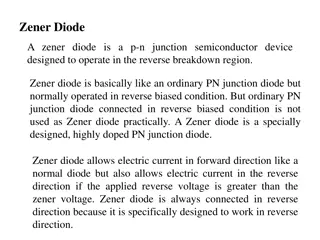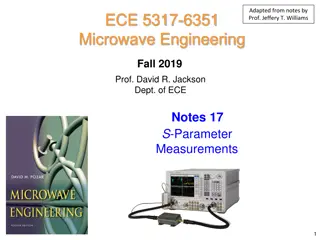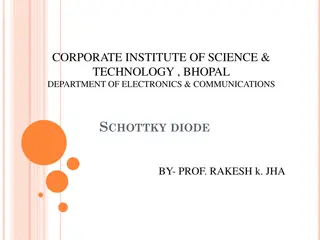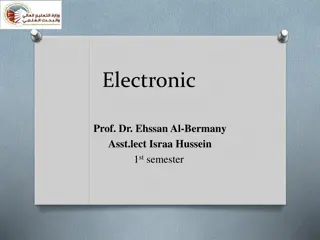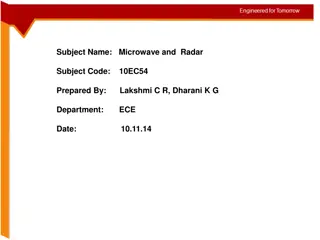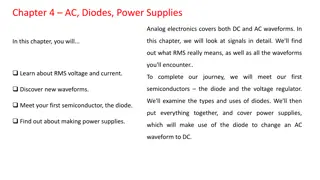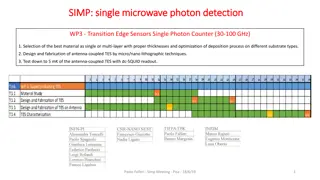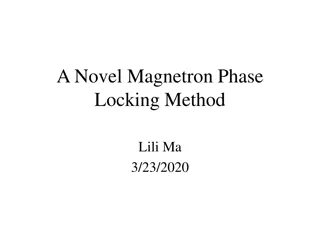Understanding Varactor Diodes in Microwave Solid-State Devices
Varactor diodes, also known as varicap diodes, play a crucial role in microwave solid-state devices by offering a much higher range of capacitance change compared to ordinary diodes. These diodes operate under reverse bias conditions, utilizing the variable capacitance effect to manipulate the junction capacitance based on the applied voltage. By understanding the operation and differences of varactor diodes, one can appreciate their significance in modern electronics.
Download Presentation

Please find below an Image/Link to download the presentation.
The content on the website is provided AS IS for your information and personal use only. It may not be sold, licensed, or shared on other websites without obtaining consent from the author. Download presentation by click this link. If you encounter any issues during the download, it is possible that the publisher has removed the file from their server.
E N D
Presentation Transcript
Microwave Solid State Devices Introduction Special electronics effects encountered at microwave frequencies severely limit the usefulness of transistors in most circuit applications. Using vaccum tubes for low power applications become impractical Need for small sized microwave devices has caused extensive research in this area This research has produced solid-state devices with higher and higher frequency ranges. The new solid state microwave devices are predominantly active, two terminal diodes, such as tunnel diodes, varactors, transferred-electron devices, and avalanche transit-time diodes
Microwave Solid State Devices Quantum Mechanic Tunneling Tunnel diode Transferred Electron Devices Gunn, LSA, InP and CdTe Avalanche Transit Time IMPATT, Read, Baritt & TRAPATT Parametric Devices Varactor diode Step Recovery Diode PIN, Schottky Barrier Diode. Microwave Transistors
VARiable reACTOR Also referred as Varicap (Variable capacitor)diode Referring to voltage-variable capacitance of reverse biased pn junction Designed to exploit the voltage-variable properties of the junction capacitance Junction capacitance depends on the applied voltage and the design of the junction Junction with fixed reverse bias may be used as a capacitance of fixed value
What is the difference between ordinary diodes and Varicap diodes? Although ordinary PN junction diodes exhibit the variable capacitance effect and these diodes can be used for this applications, special diodes optimized to give the required changes in capacitance. Varactor diodes or varicap diodes normally enable much higher ranges of capacitance change to be gained as a result of the way in which they are manufactured.
Varactor Diode - Operation The basis of operation of the varactor diode is quite simple. The diode is operated under reverse bias conditions and this gives rise to three regions. P region, N region, Depletion region P and N regions are the regions where current can be conducted Depletion region is the region where no current carriers are available P and N behave as conducting plates of a capacitor and Depletion region acts as an Insulator (dielectric in a capacitor)
Building an analogy The capacitance of a capacitor is dependent on a number of factors including the plate area, the dielectric constant of the insulator between the plates and the distance between the two plates. In the case of the varactor diode, it is possible to increase and decrease the width of the depletion region by changing the level of the reverse bias. This has the effect of changing the distance between the plates of the capacitor.
Transmission Capacitance It was established that there is a region of uncovered charge on either side of the junction that together the regions makes up the duplication region and define the depletion width Wd. The transmission capacitance (Ct) established by the isolated uncovered charges is determined by Ct= A/Wd Where is the permittivity of the semiconductor materials, A the p-n junction area and Wd the depletion width
Varactor Diode - Applications Uses in many applications where electronically controlled tuning of resonant circuits is required, for items such as oscillators and filters, varactor diodes are an essential component within the portfolio of the electronics design engineer Tuning stage of radio receiver to replace bulky variable plate capacitor Microwave frequency multiplication Active filters Voltage Controlled Oscillators RF Filters
Varactor Diodes used in VCOs Varactor diode is a key component within a VCO Oscillator within a phase locked loop VCOs are used in almost all radio, cellular and wireless receivers.
PIN Diode P-type --- Intrinsic --- N-type Used as switch and attenuator Reverse biased - off Forward biased - partly on to on depending on the bias
p-i-n Diodes Similar to the pn diode with smaller junction capacitance Very useful for a diode used a microwave switch Ls P+ n+ i Parasitics Ls~ 0.1 nH Cp~ 0.3 pF Rs~ 0.3 Rs r.b. f.b. Rp Weakly doped Cj(V) Rj(V) P-i-n structure Equivalent circuit of p-i-n
Introduction A refinement of the ordinary PN diode Works as a variable resistor at microwave frequencies PIN diode includes a layer of intrinsic material between the P and N layers As a result of the intrinsic layer, PIN diodes have a high breakdown voltage and they also exhibit a low level of junction capacitance
Basics Intrinsic material sandwiched The PIN diode operates in exactly the same way as a normal diode The only real difference is that the depletion region, that normally exists between the P and N regions in an unbiased or reverse biased diode is larger. In any PN junction, the P region contains holes as it has been doped to ensure that it has a predominance of holes. Similarly the N region has been doped to contain excess electrons. The region between the P and N regions contains no charge carriers as any holes or electrons combine As the depletion region has no charge carriers it acts as an insulator.
Basics Within a PIN diode the depletion region exists, but if the diode is forward biased, the carriers enter the depletion region (including the intrinsic region) and as the two carrier types meet, current starts to flow. When the diode is forward biased, the carrier concentration, i.e. holes and electrons is very much higher than the intrinsic level carrier concentration. Due to this high level injection level, the electric field extends deeply (almost the entire length) into the region. This electric field helps in speeding up of the transport of charge carriers from p to n region, which results in faster operation of the diode, making it a suitable device for high frequency operations
Operation When a PIN diode is forward biased, holes and electrons are injected from the P and N regions into the I-region. These charges do not recombine immediately. Instead, a finite quantity of charge always remains stored and results in a lowering of the resistivity of the I-region.
Lower Frequency Limitations A PIN diode only acts like a rectifier at low frequencies. At microwave frequencies, the IV curve undergoes a change, so that it behaves like a resistor, whose resistance value is determined by the level of DC current that is present in the I-region. Thus a PIN diode is essentially a DC-controlled high- frequency resistor. Just as important, if no DC current is present, the diode behaves like an open circuit.
PIN diode characteristics High breakdown voltage Low capacitance Carrier storage Sensitive photo detection Applications PIN Diode as a Variable Resistor Resistance value of the PIN diode is determined by only the forward biased DC current In switch and attenuator applications, the PIN diode should ideally control the RF signal level without introducing distortion which might change the shape of the RF signal.
Switches Applications Output Switch Source t Bias (1) Modulators in communication systems Wideband switch . (2) Switch in wide band system . .
Tx Rx (3) To protect receiver from the transmitter (such as in radar system) (4) Channel selection in wideband system (5) Signal path control in measurement systems As a switch the main important p-i-n diode parameters are Isolation and Insertion loss
Introduction: Gunn diodes are also known as transferred electron devices(TED) are widely used in microwave RF applications for frequencies between 1 and 100 GHz. Gallium Arsenide Gunn Diodes are made for frequencies up to 200GHz whereas Gallium Nitride can reach upto 3THz. The Gunn diode is most commonly used for generating microwave RF signals - these circuits may also be called a transferred electron oscillator or TEO. The Gunn diode may also be used for an amplifier in a transferred electron amplifier or TEA. As Gunn diodes are easy to use, they form a relatively low cost method for generating microwave RF signals.
Basics It is a form of diode used in high-frequency electronics. It is somewhat unusualthat it consists only of n- doped semiconductor material, whereas most diodes consist of both P and N-doped regions. In practice, a Gunn diode has a region of negative differential resistance. The Gunn diode is a unique component - even though it is called a diode, it does not contain a PN diode junction. The Gunn diode or transferred electron device can be termed a diode because it does have two electrodes. The Gunn diode operation depends on the fact that it has a voltage controlled negative resistance.
Principle It consists of a slice with a buffer layer between the active layer and the substrate, mounted in any of a number of packages,depending on the manufacturer,the frequency and the power level.Encapsulation is also provided to. They are grown epitaxially out of GaAs with silicon,or selenium.The substrate used here as an ohmic contact, is highly doped for good conductivity,while the thin active layer is less heavily doped. Diodes have been made with active layers varying in thickness from 40 to about 1 mm at the highest.The actual structure is normally square, and so far GaAs diodes predominate commercially.
Gunn Diode Construction The top and bottom areas of the device are heavily doped to give N+ material. The device is mounted on a conducting base to which a wire connection is made. It also acts as a heat-sink for the heat which is generated. The connection to the other terminal of the diode is made via a gold connection deposited onto the top surface. Gunn diodes are fabricated from a single piece of n-type semiconductor. The most common materials are gallium Arsenide, GaAs and Indium Phosphide, InP. However other materials including Ge, CdTe, InAs, InSb, ZnSe and others have been used. The device is simply an n-type bar with n+ contacts. It is necessary to use n-type material because the transferred electron effect is only applicable to electrons and not holes found in a p-type material.
The centre area of the device is the active region. This region is also less heavily doped and this means that virtually all the voltage placed across the device appears across this region. In view of the fact that the device consists only of n type material there is no p-n junction and in fact it is not a true diode, and it operates on totally different principles.
Operation of Gunn Diode When a voltage is placed across the device, most of the voltage appears across the inner active region. As this is particularly thin this means that the voltage gradient that exists in this region is exceedingly high. It is found that when the voltage across the active region reaches a certain point a current is initiated and travels across the active region. During the time when the current pulse is moving across the active region the potential gradient falls preventing any further pulses from forming. Only when the pulse has reached the far side of the active region, the potential gradient will rise, allowing the next pulse to be created.
Operation contd.. It can be seen that the time taken for the current pulse to traverse the active region largely determines the rate at which current pulses are generated, and hence it determines the frequency of operation. For a normal diode the current increases with voltage, although the relationship is not linear. On the other hand the current for a Gunn diode starts to increase, and once a certain voltage has been reached, it starts to fall before rising again. The region where it falls is known as a negative resistance region, and this is the reason why it oscillates.
GUNN DIODE ADVANTAGES It has much lower noise than IMPATT diodes Gunn amplifiers are capable of broad-band operation. Higher peak-to-valley ratio in its ve resistance characteristics. High fundamental frequency operation. Increased efficiency.
APLICATIONS Gunn diode oscillator as low & medium power oscillator in microwave receivers & instruments. As pump source in parametric amplifier. High-power Gunn oscillators (250- 2000mW)are used as power output oscillators.
Frequency modulator in low power transmitter. In police & CW-Doppler RADAR ,burglar alarms, aircraft rate-of-climb indicators. YIG (yttrium-iron garnet) -tuned Gunn VCOs for instrument applications.
CONCLUSION Gunn diodes are also known as Transferred electronic device (TED). Here we conclude that Gunn diode are basically used for high frequency oscillations.
IMPATT DIODE A wide variety of solid state diodes and transistor have been developed for microwave use. IMPact ionization Avalanche Transit-Time Function as microwave oscillator. Used to produce carrier signal for microwave transmission system. IMPATT can operate from a few GHz to a few hundred GHz (1 to 300 GHz ) Impact Avalanche and Transit-Time (IMPATT) Diode, also called Avalanche transit-time diodes Multilayer diodes of several different types used to generate microwave power
In contrast to other devices in this class (tunnel diodes, thyristors, and Gunn diodes), the negative resistance of avalanche-and-transit time diodes appears only at super high frequencies. Avalanche-and-transit time diodes can be made from structures of the p+-n-i-n+ type (the Read diode) or the p-i-n, p-n, p+-n, and p-n+ types
Principle of operation Negative resistance is achieved by creating a delay (1800 Phase shift) between the voltage and current. Delay is achieved by, Delay in generating the avalanche current multiplication Delay due to transit time through the material So called Avalanche transit time (ATT) devices Avalanche is generated by Carrier impact ionization TT is due to the drift in the high field domain Features Presence of P-N junctions Diode is reverse biased High field (potential gradient) is applied of the order 400 KV/cm Two modes of ATT IMPATT- Impact ionization ATT (Efficiency 5-10%) TRAPATT- Trapped plasma ATT (Efficiency 20-60%)
IMPATT DIODE Operation The diode is operated in reverse bias near breakdown, and both the N and N- regions are completely depleted Because of the difference in doping between the "drift region" and "avalanche region", the electric field is highly peaked in the avalanche region and nearly flat in drift region. In operation, avalanche breakdown occurs at the point of highest electric field, and this generates a large number of hole-electron pairs by impact ionization. The holes are swept into the cathode, but the electrons travel across the drift region toward anode. As they drift, they induce image charges on the anode, giving rise to a displacement current in the external circuit that is 180 out of phase with the nearly sinusoidal voltage waveform Figure: Impatt Diode Operation
IMPATT DIODE Operation Figure : The Build Up Of Microwave Oscillation. Figure shows the buildup of microwave oscillations in the diode current and voltage when the diode is embedded in a resonant cavity and biased at breakdown
IMPATT DIODE Operation Figure : Close Up Current And Voltage. Figure shows a close-up of the current and voltage waveforms after oscillations have stabilized. It is clear from Fig. that the current is 180 out of phase with the voltage This represents a NEGATIVE AC RESISTANCE
Operation The IMPATT diode is operated under reverse bias conditions. These are set so that avalanche breakdown occurs. This occurs in the region very close to the P+ (i.e. heavily doped P region). The electric field at the p-n junction is very high because the voltage appears across a very narrow gap creating a high potential gradient. Under these circumstances any carriers are accelerated very quickly. As a result they collide with the crystal lattice and free other carriers. These newly freed carriers are similarly accelerated and collide with the crystal lattice freeing more carriers. This process gives rise to what is termed avalanche breakdown as the number of carriers multiplies very quickly. For this type of breakdown only occurs when a certain voltage is applied to the junction. Below this the potential does not accelerate the carriers sufficiently. Once the carriers have been generated the device relies on negative resistance to generate and sustain an oscillation. The effect does not occur in the device at DC, but instead, here it is an AC effect that is brought about by phase differences that are seen at the frequency of operation. When an AC signal is applied the current peaks are found to be 180 degrees out of phase with the voltage. This results from two delays which occur in the device: injection delay, and a transit time delay as the current carriers migrate or drift across the device.
The voltage applied to the IMPATT diode has a mean value that means the diode is on the verge of avalanche breakdown. The voltage varies as a sine wave, but the generation of carriers does not occur in unison with the voltage variations. It might be expected that it would occur at the peak voltage. This arises because the generation of carriers is not only a function of the electric field but also the number of carriers already in existence. As the electric field increases so does the number of carriers. Then even after the field has reached its peak the number of carriers still continues to grow as a result of the number of carriers already in existence. This continues until the field falls to below a critical value when the number of carriers starts to fall. As a result of this effect there is a phase lag so that the current is about 90 degrees behind the voltage. This is known as the injection phase delay. When the electrons move across the N+ region an external current is seen, and this occurs in peaks, resulting in a repetitive waveform.
Advantages High power capability These are based on silicon are most most suitable for millimeter wave power. A millimeter wave covers the wavelength range from 10mm to 1mm corresponding to 30- 300 GHz Provides potentially reliable and compact Inexpensive moderate efficient microwave power sources Disadvantages It is very noisy because avalanche is a noisy process Tuning range is not as good as Gunn diodes Noise figure is 30dB are not as good as Klystron/Gunn/TWT amplifier
IMPATT Diodes Applications Used as microwave oscillators Microwave generators Modulated output oscillators Receiver local oscillators parametric amplifier in pumps Suitable for negative resistance amplification High Q IMPATT s are useful in intrusion alarm networks, police radars Low Q IMPATT s are useful in FM telecommunication transmitters and CW doppler radar transmitter
Semiconductor Microwave Devices Most microwave devices are fabricated on a GaAs substrate because of its high mobility. A silicon substrate, on the other hand, has the advantages of low cost and high yield. The following table summarizes the various microwave solid-state devices and their applications. Frequency Limitation Substrate Material Device Major Applications IMPATT < 300 GHz Si, GaAs, InP Transmitters Amplifiers Local oscillators, Amplifiers Transmitters Amplifiers , Oscillators, Switches, Mixers, and Phase shifters Switches, Limiters, Phase shifters, Modulators, and Attenuators Multipliers, Tuning, Phase shifters, and Modulators Gunn < 140 GHz GaAs, InP FET&HEMT < 100 GHz GaAs, InP p-i-n < 100 GHz Si, GaAs Varactor < 300 GHz GaAs





